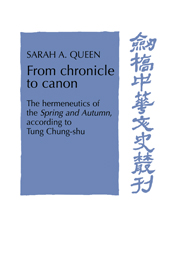Book contents
- Frontmatter
- Contents
- List of tables
- Acknowledgments
- List of abbreviations
- 1 Introduction
- PART I Three perspectives on the authenticity of the Ch'un-ch'iu fan-lu
- PART II Exegesis and canonization
- 5 The Spring and Autumn and Kung-yang tradition
- 6 Reforming the Ch'in laws
- 7 The wider circle of Han jurisprudence
- 8 Refashioning the imperial rites
- 9 Canon, cosmos, and court patronage
- 10 Conclusion
- Appendix 1 The birth and death dates of Tung Chung-shu
- Appendix 2 The dates of the Han-shu 56 memorials
- Appendix 3 Han transmission of Kung-yang learning
- Appendix 4 Han dynasty disciples of Tung Chung-shu
- Appendix 5 Citations and titles attributed to Tung Chung-shu
- Appendix 6 Transmission of Ch'un-ch'iu fan-lu editions
- Selected bibliography
- Index
10 - Conclusion
Published online by Cambridge University Press: 10 December 2009
- Frontmatter
- Contents
- List of tables
- Acknowledgments
- List of abbreviations
- 1 Introduction
- PART I Three perspectives on the authenticity of the Ch'un-ch'iu fan-lu
- PART II Exegesis and canonization
- 5 The Spring and Autumn and Kung-yang tradition
- 6 Reforming the Ch'in laws
- 7 The wider circle of Han jurisprudence
- 8 Refashioning the imperial rites
- 9 Canon, cosmos, and court patronage
- 10 Conclusion
- Appendix 1 The birth and death dates of Tung Chung-shu
- Appendix 2 The dates of the Han-shu 56 memorials
- Appendix 3 Han transmission of Kung-yang learning
- Appendix 4 Han dynasty disciples of Tung Chung-shu
- Appendix 5 Citations and titles attributed to Tung Chung-shu
- Appendix 6 Transmission of Ch'un-ch'iu fan-lu editions
- Selected bibliography
- Index
Summary
The Han dynasty marked the beginning of a new era. For two thousand years before the Han, China had been dominated by clans that had held together the many semiautonomous and semiindependent principalities populating China's political landscape through manipulating kinship ties, controlling civil and religious ritual, and exercising military power. For two thousand years after the Han, China was essentially a unified empire ruled by a Son of Heaven. The ideological shift that accompanied such a profound political change, initiated during the Warring States period, was orchestrated by Tung Chung-shu, who successfully resurrected an older ideal of rulership and reconciled it with cosmological ideas current in the Han; by the end of the dynasty, the ideal emperor was both a sage-king and a high priest. The old order had gradually broken down in its past five hundred years, as principalities competed for hegemony, elites forsook their hierarchical niches to strive for prestige and power, economic and technological developments created new concentrations of wealth, and new ideas fermented in this ripe medium. The eventual Ch'in unification in the late third century was a triumph of realpolitik over the ideals that, beginning about 500 b.c.e., philosophers had taken from (or read into) the earlier Chou order. Han scholastics then transformed the conquest regime that it had inherited into one of China's long-lasting dynasties by turning away from radical realpolitik to adapt the ideals of the Confucian scriptures to their age.
- Type
- Chapter
- Information
- From Chronicle to CanonThe Hermeneutics of the Spring and Autumn according to Tung Chung-shu, pp. 227 - 240Publisher: Cambridge University PressPrint publication year: 1996

